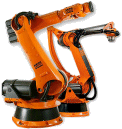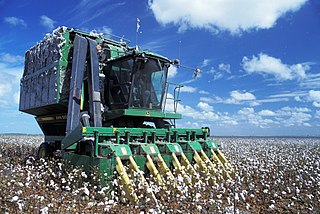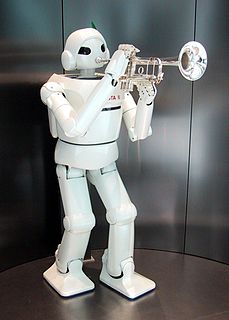Related Research Articles
The term mecha may refer to both scientific ideas and science fiction genres that center on giant robots or machines (mechs) controlled by people. Mechas are typically depicted as humanoid mobile robots. The term was first used in Japanese (meka) after shortening the English loanword mekanikaru ('mechanical'), but the meaning in Japanese is more inclusive, and "robot" (robotto) or "giant robot" is the narrower term.

A robot is a machine—especially one programmable by a computer— capable of carrying out a complex series of actions automatically. Robots can be guided by an external control device or the control may be embedded within. Robots may be constructed on the lines of human form, but most robots are machines designed to perform a task with no regard to their aesthetics.

An industrial robot is a robot system used for manufacturing. Industrial robots are automated, programmable and capable of movement on three or more axes.

Automation, or Labor-saving technology is the technology by which a process or procedure is performed with minimal human assistance. Automation or automatic control is the use of various control systems for operating equipment such as machinery, processes in factories, boilers and heat treating ovens, switching on telephone networks, steering and stabilization of ships, aircraft and other applications and vehicles with minimal or reduced human intervention.

The Yaskawa Electric Corporation is a Japanese manufacturer of servos, motion controllers, AC motor drives, switches and industrial robots. Their Motoman robots are heavy duty industrial robots used in welding, packaging, assembly, coating, cutting, material handling and general automation.
The KHR-1 is a programmable, bipedal humanoid robot introduced in June 2004 by a Japanese company Kondo Kagaku. At the time of its introduction it was one of the least expensive programmable bipedal robots. The robot is 34 cm high and has 17 degrees of freedom. It is capable of a wide range of motions, including quick kung-fu-style fighting moves.

"Rust Belt" is an informal term for a region of the United States that has been experiencing industrial decline starting around 1980. It is made up largely of the Great Lakes Megalopolis, though definitions vary. Rust refers to the deindustrialization, or economic decline, population loss, and urban decay due to the shrinking of its once-powerful industrial sector. The term gained popularity in the U.S. in the 1980s.
Teradyne, Inc., based in North Reading, Massachusetts in the United States, is a developer and supplier of automatic test equipment (ATE). The company's divisions Semiconductor Test and Systems Test Group, are organized by the products they develop and deliver. Teradyne's high-profile customers include Samsung, Qualcomm, Intel, Analog Devices, Texas Instruments and IBM.

FANUC is a group of companies that provide automation products and services such as robotics and computer numerical control wireless systems. These companies are principally FANUC Corporation of Japan, Fanuc America Corporation of Rochester Hills, Michigan, USA, and FANUC Europe Corporation S.A. of Luxembourg.

Joseph Frederick Engelberger was an American physicist, engineer and entrepreneur. Licensing the original patent awarded to inventor George Devol, Engelberger developed the first industrial robot in the United States, the Unimate, in the 1950s. Later, he worked as entrepreneur and vocal advocate of robotic technology beyond the manufacturing plant in a variety of fields, including service industries, health care, and space exploration. He has been called "the father of robotics" for his contributions to the field.
KUKA is a German manufacturer of industrial robots and solutions for factory automation. It is owned by the Chinese company Midea Group.

Mechanised agriculture is the process of using agricultural machinery to mechanise the work of agriculture, greatly increasing farm worker productivity. In modern times, powered machinery has replaced many farm jobs formerly carried out by manual labour or by working animals such as oxen, horses and mules.

Wakamaru is a Japanese robot made by Mitsubishi Heavy Industries that is intended to perform natural communication with human beings. The yellow, 3-foot domestic robot debuted in 2005 at a $14,300-$15,000 USD price-point exclusively for Japanese households. Through its development, the Wakamaru has been used for presenting at exhibitions, guiding customers, and working as a desk receptionist. However, the Wakamaru has not advanced beyond its first model that was released in 2005.

PackBot is a series of military robots by Endeavor Robotics, an international robotics company founded in 2016, created from iRobot, that previously produced military robots since 1990. More than 2000 were used in Iraq and Afghanistan. They were also used to aid searching through the debris of the World Trade Center after 9/11 in 2001. Another instance of the PackBot technology being implemented was to the damaged Fukushima nuclear plant after the 2011 Tōhoku earthquake and tsunami where they were the first to assess the site. As of November 2014, the U.S. Army is refurbishing 224 iRobot 510 robots. The PackBot technology is also used in collaboration with NASA for their rovers and probes.

DENSO Corporation is a global automotive components manufacturer headquartered in the city of Kariya, Aichi Prefecture, Japan.

In Japan, popular robots include humanoid entertainment robots, androids, animal robots, social robots, guard robots, and many more. Each type has a variety of characteristics.

The history of robotics has its origins in the ancient world. The modern concept began to be developed with the onset of the Industrial Revolution, which allowed the use of complex mechanics, and the subsequent introduction of electricity. This made it possible to power machines with small compact motors. In the early 20th century, the notion of a humanoid machine was developed. Today, one can envisage human-sized robots with the capacity for near-human thoughts and movement.

Robots of the United States include simple household robots such as Roomba to sophisticated autonomous aircraft such as the MQ-9 Reaper that cost 18 million dollars per unit. The first industrial robot, robot company, and exoskeletons as well as the first dynamically balancing, organic, and nanoscale robots originate from the United States.

A technological revolution is a period in which one or more technologies is replaced by another technology in a short amount of time. It is an era of accelerated technological progress characterized by new innovations whose rapid application and diffusion cause an abrupt change in society.

A domestic robot is a type of service robot, an autonomous robot that is primarily used for household chores, but may also be used for education, entertainment or therapy. Thus far, there are only a few limited models, though speculators, such as Bill Gates, have suggested that they could become more common in the future. While most domestic robots are simplistic, some are connected to WiFi home networks or smart environments and are autonomous to a high degree. There were an estimated 16.3 million service robots in 2018.
References
- ↑ "A (Social) History of Robots(and maybe some consequences of same)" (PDF). Retrieved 2010-04-05.
